Security Forces Spotlight: Women’s History Month
Pentagon, Washington, D.C.
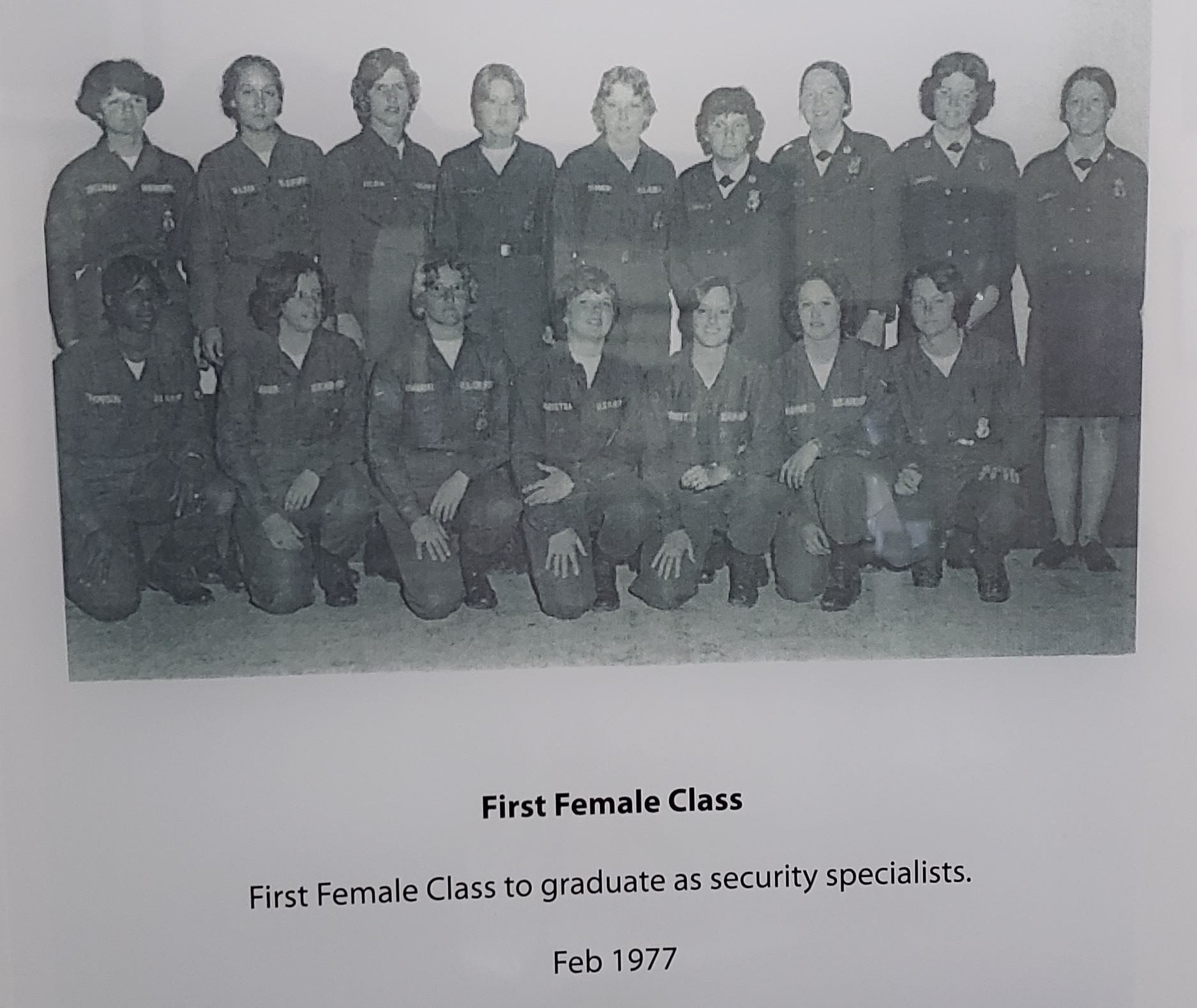
Women’s History Month stems from International Women’s Day, which the United Nations began observing in 1975, “to recognize the fact that securing peace and social progress and the full enjoyment of human rights and fundamental freedoms require the active participation, equality and development of women; and to acknowledge the contribution of women to the strengthening of international peace and security.”
In 1980, President Jimmy Carter issued the first presidential proclamation declaring the week of March 8th as National Women’s History week for the United States. The National Women’s History Project petitioned to expand the event to the entire month of March six years later.
Women’s Army Auxiliary Corps
Before the advent of the Women’s Army Auxiliary Corps, women worked alongside official military members without legal protection, medical care, and benefits. In 1941, Congress authorized the Women’s Army Auxiliary Corps (WAAC).
Spurred by the attack on Pearl Harbor, Dec. 7, 1941, over 35,000 women applied for less 1,000 positions within the WAAC. Women initially served as clerks, typists, drivers, cooks, and unit cadre, but gradually, the Army realized women could fulfill more versatile roles.
While this was a step in the right direction, women were paid less than their male counterparts and lacked the same benefits.
To combat the decline in recruiting efforts, bills were introduced and approved in Congress dropping the “auxiliary” status of the WAAC and allowing women to receive all of the rank, privileges, and benefits of their male counterparts.
Women continue to break down barriers and take on challenging assignments, demonstrating not only that they belong, but that they can lead fellow Airmen.
In 2019, 1st Lt. Chelsey Hibsch was the first Air Force female Airman to earn the Army Ranger Tab. 1st Lt. Chelsey Hibsch, along with her classmates, underwent rigorous tasks, challenging themselves mentally and physically, testing their ability to persevere despite adversity.
Often known as the one of the Army’s toughest courses, Ranger school seeks to develop proficiency in small unit tactics and combat leadership.
Women in the Air Force
During WWII, female Airmen served as weather forecasters and observers, electrical specialists, sheet metal workers, link trainer instructors, control tower specialists, airplane mechanics, photo-laboratory technicians and photo interpreters.
The Air Force also created two female flying units, which were allowed to fly stateside assignments.
More than 1,000 women were trained on every aircraft in the Army’s arsenal, flying gunnery targets, transporting equipment and personnel, and flight-testing repaired aircrafts. President Jimmy Carter granted military status to the Women’s Airforce Service Pilots in 1977.
Retired Air National Guard Brigadier General Linda McTague joined the Air Force in 1981 before women could fly combat aircraft.
Eager to fly, McTague flew operational support aircraft, working her way to the command position of the District of Columbia Air National Guard’s 201st Airlift Squadron in 1997.
In 2003, McTague took command of the D.C. Air National Guard’s 113th Wing, including the 121st Fighter Squadron and her previous squadron, the 201st Airlift Squadron.
While McTague never viewed herself as a “pioneer”, she paved the way for women to follow not only in her footsteps but pursue careers in other areas of the Air Force.
Women in Security Forces
Women were able to enter the law enforcement specialist training for the first time in 1971.
Today, females make up 21.3% of the Air Force population, which 22.6% serving as officers and 20.9% serving in the enlisted corps. Senior leaders are actively looking at how to reduce barriers and increase retention, progression, and development. Female Defenders have numerous prospects exciting opportunities available to them. The Director of Security Forces created the Female Defender Initiative which aims to improve retention, progression, and development within the Career Field.
In 2018, Senior Airman Jessica Ortiz-Villa became the first woman in Air Force Global Strike Command to become a Raven. Ravens are specially trained security forces personnel who provide security for aircraft that travel through high threat areas.
Ravens are trained at McGuire Air Force Base, New Jersey, covering cross-cultural awareness, legal considerations, embassy operations, airfield survey techniques, explosive ordinance awareness, and aircraft searches.
Security Forces has a new female Career Field Manager, Ms. Kay Rodgers.
To find out more about the critical work that Security Forces does, visit the website. Follow us on @afdefenders or www.facebook.com/AFDefenders to stay up to date!
Security Forces Airman, BCSO Deputies Apprehend Three after High-Speed Chase
3 March 2022, Patrick Space Force Base, FL
By A1C Samuel Becker
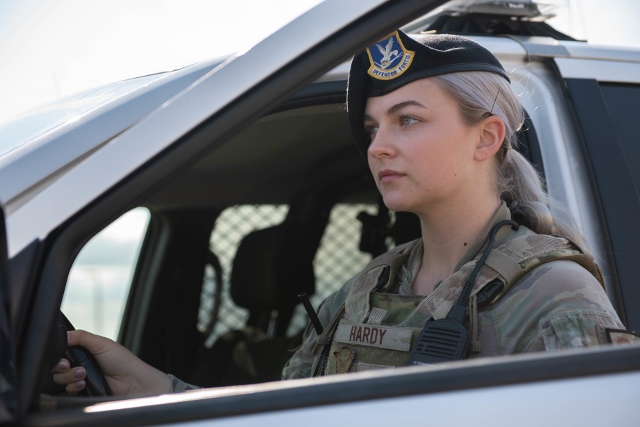
U.S. Air Force Senior Airman Sarah Hardy, 45th Security Forces Squadron installation patrolman, scans the fence line at Patrick Space Force Base, Fla., Feb. 11, 2022. Hardy helped apprehend three suspects after a high-speed chase in December 2021. (U.S. Space Force photo by Airman 1st Class Samuel Becker)
Defenders from the 45th Security Forces Squadron apprehended three occupants of a stolen vehicle from St. Augustine, Florida, after a high-speed chase near Patrick Space Force Base Dec. 16, 2021.
U.S. Air Force Senior Airman Sarah Hardy, 45th SFS installation patrolman, was conducting checks of the Pineda Beach parking lot, which is part of Patrick SFB property, when she noticed a suspicious vehicle at the east side of the parking lot.
She pulled behind the vehicle, a Chevrolet Silverado, and requested U.S. Air Force Staff Sgt. Matthew Dusek, 45th SFS base defense operations controller, conduct a National Crime Information Center/Florida Crime Information Center (NCIC/FCIC) check on the vehicle.
While the plates were being run, the Silverado left the parking lot with Hardy close behind.
A few moments later, Dusek discovered the vehicle had been reported stolen, along with a handgun, which was reportedly inside the vehicle with two magazines, and relayed that information to Hardy.
“When I heard that the vehicle was stolen, I turned on my overhead lights,” said Hardy. “The vehicle immediately sped off in an erratic manner turning onto Pineda Causeway.”
“It was a stressful situation,” said Dusek. “I immediately let her know that they were likely armed with a weapon.”
Dusek also requested the Brevard County Sheriff's Office respond to assist Hardy, who was pursuing the truck as it traveled west on Pineda Causeway.
“Our speeds reached well over 100 mph,” Hardy said. “The vehicle was driving erratically and weaving in and out of traffic, but I was focused, and my training took over.”
At approximately 7:30 p.m., the Silverado collided with a Toyota Tundra halfway between Merritt Island and Satellite Beach, then collided with a concrete guardrail before stopping.
Fearful that she could face a lethal threat, Hardy exited her patrol car with her weapon drawn, a Sig Saur 9mm handgun, and took cover.
Shortly thereafter she was joined by BCSO deputies.
Dylan Weber was the first BCSO deputy to arrive on scene.
“Me and Weber had all occupants of the vehicle exit one by one,” said Hardy. “Then we instructed them to (assume) a kneeling position at the rear of the vehicle until backup arrived.”
Minutes later, two more deputies arrived from the BCSO. They instructed each suspect to walk backwards toward them and Hardy handcuffed each one.
Hardy then demanded any other occupants who may be in the Silverado to get out. Then, she and the BCSO deputies performed a tactical sweep of the vehicle.
“Deputy Weber and I noticed the smell of marijuana emitting from the silverado, as well as a handgun on the passenger side floorboard with two loaded magazines,” said Hardy.
After searching the Silverado, Hardy checked on the driver of the Tundra, she said. He was shaken from the incident, but refused medical attention.
“Hardy did an outstanding job,” said U.S. Air Force Tech. Sgt. Casey Klask, 45th SFS flight sergeant. “I couldn't have handled it any better.”
Eielson Defenders Bring New Capabilities through Federal Accreditations
By Staff Sgt. Beaux Hebert, 354th Fighter Wing Public Affairs, 7 January 2022
EIELSON AIR FORCE BASE, Alaska --
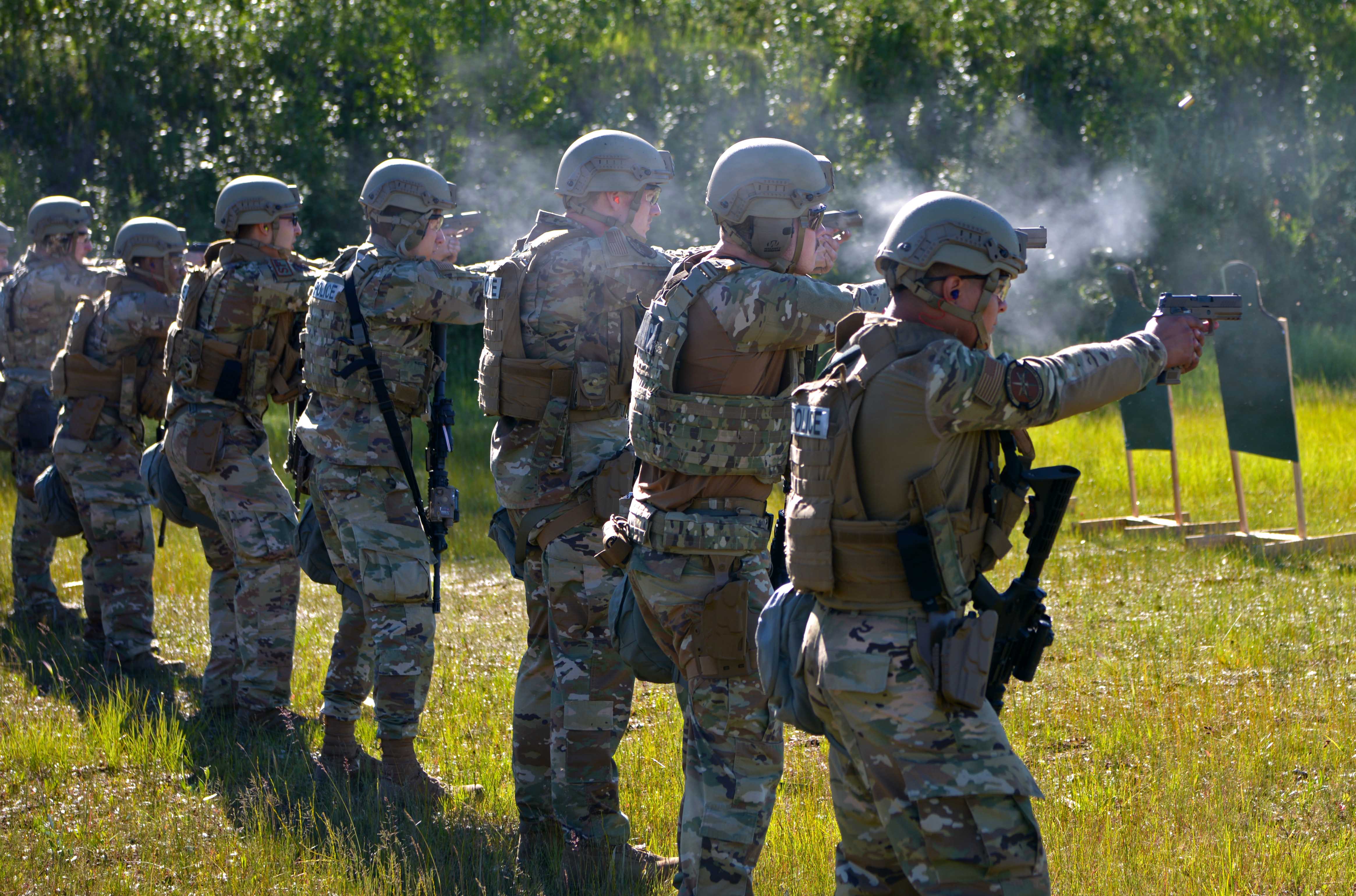 Airmen from the 354th Security Forces Squadron fire handguns during a Special Response Team tryout 23 June 2021, on Eielson AFB, AK. With the addition of these security forces assets, Eielson’s lethality and readiness increases tremendously. (U.S. Air Force photo by SSgt Beaux Hebert)
Airmen from the 354th Security Forces Squadron fire handguns during a Special Response Team tryout 23 June 2021, on Eielson AFB, AK. With the addition of these security forces assets, Eielson’s lethality and readiness increases tremendously. (U.S. Air Force photo by SSgt Beaux Hebert)
Newly appointed Air Advisors, Crisis Negotiators and Special Reaction Team (SRT) Defenders from the 354th Security Forces Squadron were recognized by their squadron leadership Jan. 7, 2022 at a ceremony on Eielson Air Force Base, Alaska.
“Today we are recognizing our recent graduates of a federally-certified crisis negotiations course, federally certified SRT course and our new air advisors,” said 1st Lt. Adam Paini, the 354th SFS Contingency Operations officer in charge.
Air advisors work with partner nations to develop their aviation enterprises using the skills they already have as an Airman. Air advisors are trained to do five core functions: assess, train, advise, assist and equip. Eielson’s Air Advisor Defenders will be crucial when integrating with partner nations during Agile Combat Employment (ACE) situations.
Crisis Negotiators are security forces Defenders trained to successfully negotiate with emotionally distraught or deranged individuals. These Defenders have practiced and learned how to react to highly volatile situations, making every effort to use what they've learned to resolve the situations peacefully. This is a crucial asset to Eielson due to the harsh Alaskan weather and increased darkness contributing to mental health problems for some Airmen.
An SRT is the military version of civilian law enforcement’s special weapons and tactics (SWAT). They are dedicated to the preservation of life and property during critical incidents and high-risk operations. They are called upon to respond for service of high-risk search and arrests; incidents involving barricaded suspects, hostage rescues, or active shooters; crowd control; and other situations requiring resources beyond the capacity of the normal operations.
“This course has helped me become a better Defender,” said Airman 1st Class Wyatt Wilsey, an SRT course graduate. “The tactics and capabilities I learned there make me a more lethal and capable defender. I also look forward to passing on this knowledge to the rest of the squadron to help us all become better.”
With the addition of these security forces assets, Eielson’s lethality and readiness increases tremendously.
 SrA Alexandranell Soto, a 354th Security Forces Special Response Team member, receives her duty identifier patch during a recognition ceremony 7 January 2022, on Eielson AFB, AK. An SRT is the military version of civilian law enforcement’s special weapons and tactics (SWAT). They are dedicated to the preservation of life and property during critical incidents and high-risk operations. (U.S. Air Force photo by A1C Elizabeth Schoubroek)
SrA Alexandranell Soto, a 354th Security Forces Special Response Team member, receives her duty identifier patch during a recognition ceremony 7 January 2022, on Eielson AFB, AK. An SRT is the military version of civilian law enforcement’s special weapons and tactics (SWAT). They are dedicated to the preservation of life and property during critical incidents and high-risk operations. (U.S. Air Force photo by A1C Elizabeth Schoubroek)
“These newly trained Airmen bring capabilities that we’ve never had before,” Paini said. “Defenders receive a decent amount of training for crisis response and high-risk events but very little specialized training. We were able to give these Airmen an opportunity to step outside the normal routine and receive training from different military branches and civilian departments which allows us to be more capable than a typical security forces unit when faced with those unique situations.”
Looking towards the future, the 354th SFS is going to offer more of these opportunities to their Airmen to continue to build up Eielson’s lethality and readiness.
“This is only the first iteration of getting Airmen certified. We want to continue to give these opportunities to all our Airmen and integrate the training they learned into our daily battle rhythm.” Paini said.
20th Security Forces Career Field Manager Selected
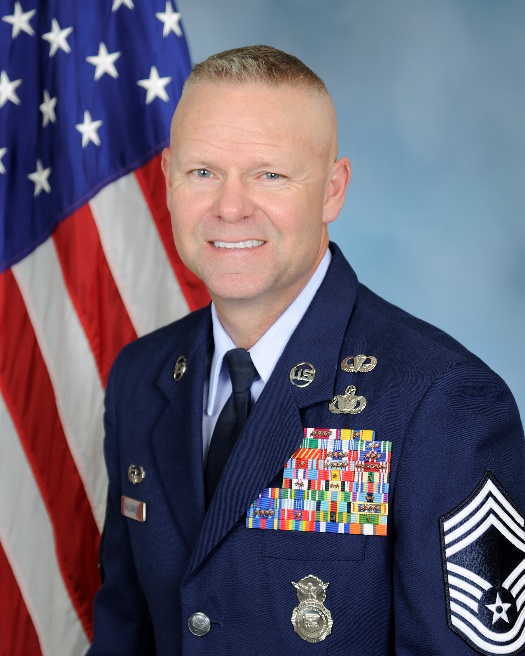 Chief Master Sgt. Donald S. Gallagher has been selected to become the 20th Security Forces Career Field Manager, becoming the top enlisted advisor to the Air Force Director of Security Forces.
Chief Master Sgt. Donald S. Gallagher has been selected to become the 20th Security Forces Career Field Manager, becoming the top enlisted advisor to the Air Force Director of Security Forces.
In this role, Chief Gallagher will advise on security forces policy, organizing, training, equipping, and maintaining mission readiness impacting over 38,000 total force Defenders.
In selecting Chief Gallagher, Brig. Gen. Roy W. Collins, Director of Security Forces, said “Chief Gallagher is the Chief we need right now to lead the Security Forces Enterprise with all of the challenging and exciting things we will do in 2022.”
Brig Gen Collins went on to say, “Chief Gallagher definitely has the experience, new ideas, and teamwork mindset to lead our Enterprise.”
Chief Gallagher will takeover in April 2022. “It’s an unbelievable honor to have Brig Gen Collins select me to be his next Wingman. I am excited for this next challenge and I am so proud for the chance to represent and advocate for “Defender Nation”, 2022 is going to be a big year and I can’t wait to get after it,” Gallagher said.
CMSgt Gallagher is thoroughly prepared for the new assignment.
Prior to his selection as the next CFM, Chief Gallagher served as the Security Forces Manager (SFM) for Air Force Global Strike Command. In this capacity, he provides executive management and support for over 6,000 Security Forces Airmen assigned to 24 squadrons across nine wings on eight installations.
Chief Gallagher serves as the command’s principal Security Forces advisor on enlisted issues and interprets and ensures enforcement of nuclear and non-nuclear policy directives in order to execute combatant command war time taskings. Chief Gallagher makes and advocates leadership decisions deliberately motivating, coaching, and inspiring Airmen to become better followers, supervisors, and leaders. Ultimately delivering a more ready and agile Defender force to protect “Striker” installations, resources, and personnel.
Chief Gallagher “Crossed into the Blue” in 2003 after serving in the U.S. Army as a Military Policeman, Infantryman, and a Cavalry Scout. Chief Gallagher served in the US and Korea with deployments in Egypt, Uzbekistan, Iraq, Afghanistan, Haiti and Qatar.
He was also the Chief Enlisted Manager of the 343d Training Squadron, “The Security Forces Academy”, at Joint Base San Antonio-Lackland, Texas.
“Chief Gallagher will help Defender Nation prepare for the Air Base Ground Defense mission and improve our Law Enforcement proficiency” said Collins. “I am confident in his ability to take us to the next level as we start executing on DEFNEXT32.”
Security Forces, Local Law Enforcement Partner for Police Pursuit Training
TYNDALL AIR FORCE BASE, FL, UNITED STATES
325th Fighter Wing Public Affairs, by SSgt Magen M. Reeves, 22 December 2021
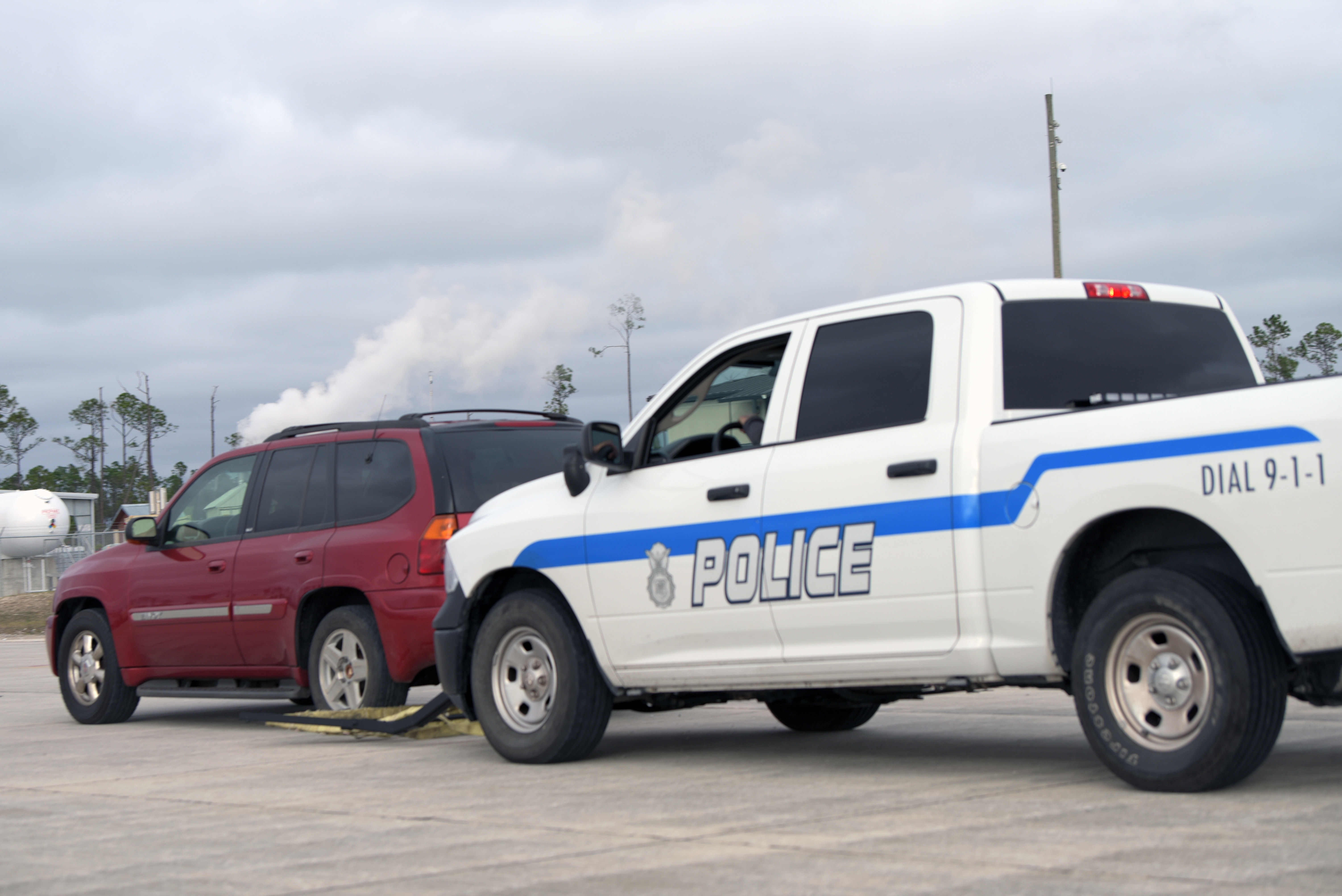
A grappler net deployed from the front fender of a 325th Security Forces Squadron truck and wrapped around the tire of a simulated runaway vehicle at Tyndall Air Force Base, Florida, Dec. 21, 2021. The grappler system utilizes a netting which wraps around the runaway vehicle’s tire, forcing the tire to seize up and come to a stop. (U.S. Air Force photo by Staff Sgt. Magen M. Reeves)
The 325th Security Forces Squadron partnered with the Bay County Sheriff’s Office and Stock Enterprises LLC to conduct police pursuit training utilizing a grappler system at Tyndall Air Force Base, Florida, Dec. 21, 2021.
The grappler system is a new piece of equipment Defenders use to assist in their continued efforts in protecting and serving Airmen and the local community.
“The utilization of the grappler system adds another layer to the [Installation Integrated Defense Plan] by giving Defenders another tool to stop would be gate runners or hostile actors,” said Tech. Sgt. Phillip Hembree, 325th SFS resource advisor.
Approximately 18 miles of U.S. Highway 98 runs through Tyndall. Security forces members and civilian law enforcement agencies share jurisdiction of the highway, performing continuous training to enhance the security and safety of the communities.
“Having this system installed and clearly visible presents a significant deterrent,” said Hembree.
Stock Enterprises has been contracted by multiple bases since Beale Air Force Base, California, first acquired a grappler in 2018. There are approximately 17 grapplers in use at installations across the Air Force.
“The system utilizes a netting which leashes to a subject’s rear vehicle tire,” Hembree said. “It will then wrap around [the tire] utilizing the forward momentum of the tire forcing the tire to seize up resulting in the vehicle to be immobilized.”
In addition to the BCSO, Defenders worked with the inventor of the grappler product to ensure proper training techniques were passed to the unit.
“Creating and fostering a relationship with local law enforcement entities is a crucial element of securing Tyndall,” said Hembree.
Allowing security forces members the chance to see the grappler system in action gives context and provides a well-rounded understanding of how, when, where and why to employ the grappler.
“Conducting these joint training exercises and demonstrations sets a framework of how each organization operates and training methodologies,” Hembree said. “This enable Defenders and other law enforcement agencies to be in sync during joint responses where time is of the essence.”
Page 10 of 51


